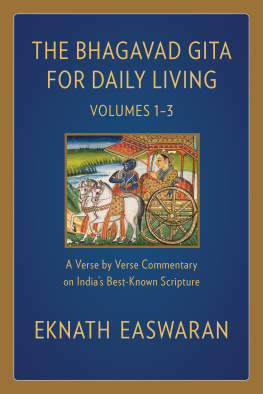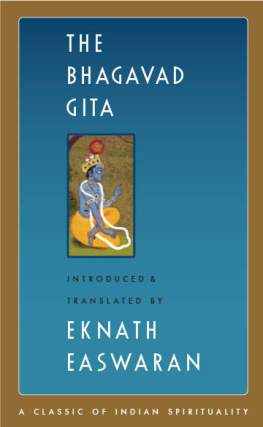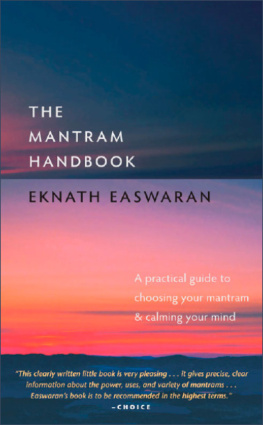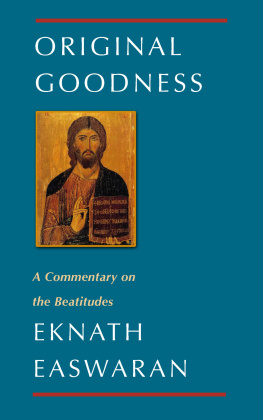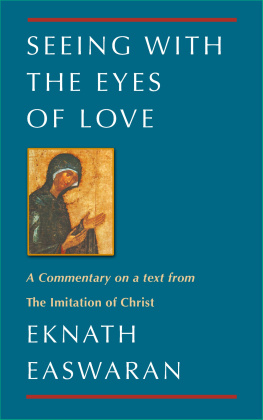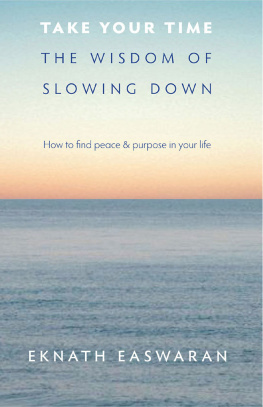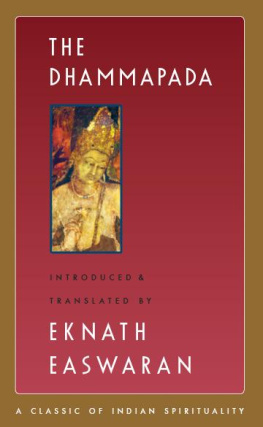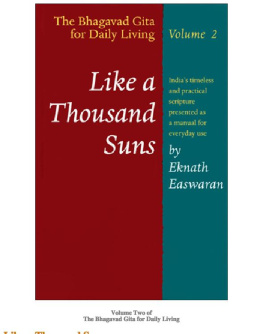Table of Contents
EKNATH EASWARAN & HIS WORK
Eknath Easwaran was a prolific author and tireless teacher with a gift for making complex spiritual topics practical and clear. At the time of his passing, in 1999, his twenty-six books on spiritual living had been translated into twenty-four languages and his Eight Point Program was used and respected around the world. Today, retreats at the Blue Mountain Center of Meditation, which he founded in 1961, continue to attract participants of all ages, backgrounds, and faiths, testimony to a timeless message as relevant now as ever.
Easwaran left a rich archive with thousands of recorded talks, as well as works in progress to be completed under the direction of his wife and editor, Christine Easwaran. Drawn from essays and other unpublished material, Strength in the Storm is the first of these works to appear since Easwarans passing. With it, Nilgiri Press is pleased to introduce this well-loved author to a new century and new generations.
Our logo represents the ceremonial oil lamp used in homes and temples throughout Kerala, South India, where Eknath Easwaran was born and raised. Little Lamp is the pet name given to him by his maternal grandmother and spiritual teacher.
Christine Easwaran, wife of Eknath Easwaran, is president of the Blue Mountain Center of Meditation and editorial director of Nilgiri Press. She has been active in Easwarans work since 1960, carrying his teaching to a wider audience.
About This Book
By Christine Easwaran
This book is about coping with stress and anxiety - finding strength to meet the challenges and even the major crises that all of us face in everyday life.
I dont know anyone better qualified to make this presentation than Eknath Easwaran. In our forty years together, I saw him weather crisis after crisis with love, compassion, and a clear-eyed faith in individual goodness that nothing could shake.
Of course, in saying this I cannot claim to be objective. My life has been linked with his since I first heard him speak in 1960, when he was at the peak of his academic career. A full professor of English at a major Indian university and known throughout India as a writer and lecturer, Easwaran had come to the University of California at Berkeley on the Fulbright exchange program. He was giving talks around the Bay Area on the spiritual heritage of India, and I was attracted to a series offered at a bookstore in San Francisco.
Although Easwaran drew large crowds on some of these occasions, that evening he had the intimate atmosphere he preferred all his life: a group of thirty to fifty people - about classroom size - in a setting personal enough for him to speak to each person heart to heart. These were not dry academic talks. To him, the worlds spiritual traditions were not topics for philosophy or religion. They were living waters, practical resources for everyday living. And he was a gifted, inspired teacher. I saw at once that he had answers to questions I had been asking, and he had a burning desire to share his insights with all who would listen.
I quickly joined the small group of people who surrounded him at the various locations in the Bay Area where he was making friends and influencing lives. Eager to help him spread his message, we provided transportation, meeting places, fresh audiences, whatever was needed. Eventually someone suggested that he formalize his work, and the Blue Mountain Center of Meditation was established late in 1961.
From those small beginnings, mostly by word of mouth, Easwarans reach grew. Books based on his talks began to appear, beginning with Gandhi the Man in 1972. By the time of his passing, in 1999, he had two dozen books translated into as many languages, and thousands of people around the world were following his Eight Point Program of passage meditation.
Meditation, however, requires systematic daily practice - a big hurdle in todays hurried world. For every individual who has learned to meditate along Easwarans lines, there are thousands more whose lives have been changed simply by reading his books, drawing inspiration from his talks, or practicing some of the other skills in his Eight Point Program.
This book is intended for that much larger audience. Written with the authority of a gifted teacher of meditation, it doesnt assume that you want to meditate - at least not yet! Its purpose is to present other skills that anyone, even a child, can use to help face the challenges that life brings.
The key to facing these challenges, Easwaran maintains, is the mental state with which we meet them. All of us have inner resources for dealing creatively with what life throws at us. We simply have to learn how to release those resources - and that, he teaches, is essentially a matter of quieting the agitation in the mind. Its a simple idea, but one that goes deep: a truly calm mind can weather any storm.
Easwaran spent almost forty years teaching ordinary men and women how to keep their minds calm and kind in crisis, so that they become a center of strength for themselves and those around them. This is no quick fix; its something we go on learning throughout our lives. Yet dramatic changes can come almost immediately, as I hope youll discover for yourself when you try some of the simple techniques in this book.
Youll see three sections in each chapter:

An introduction presenting Easwarans timeless ideas in the light of problems and challenges that ordinary people face today.

Easwarans article - the main part of each chapter - follows my introduction. Each article presents a key idea, such as how living in the present helps keep the mind calm and secure.
These articles came from Easwarans informal talks to close students, heightening the impression that he is speaking directly to us. Imagine yourself in his audience, listening to his stories, smiling at his gentle humor, sharing in his insights.
One person who comes up repeatedly in these articles is Easwarans maternal grandmother, whom he later came to revere as his spiritual teacher. (The maternal lineage is important because the Eknath name is carried by the mother - part of an ancient matriarchal tradition in Kerala, South India, in which women have had land rights for centuries and are noted for their strength and independence.) Granny, as Easwaran calls her, was his primary inspiration for translating spiritual wisdom into everyday life.
As you read these articles, youll also find sidebars with illustrations from some of the people who tell us their difficulties and successes in applying Easwarans teachings in the real world. (Weve changed names and other details as necessary to protect privacy.) These examples help show the practical applications of what Easwaran is talking about.

A workbook section concludes each chapter. These pages, based on years of experience in presenting Easwarans teachings at retreats, are designed to help you get the most out of each article. A list of Key Ideas is followed by two pages of suggested activities - Points to Practice- and an inspirational passage of poetry or prose that speaks to the chapters theme. This is the same kind of passage used in Easwarans method of meditation, in which we absorb high ideals by filling our minds with them and then trying our best to live them out each day.

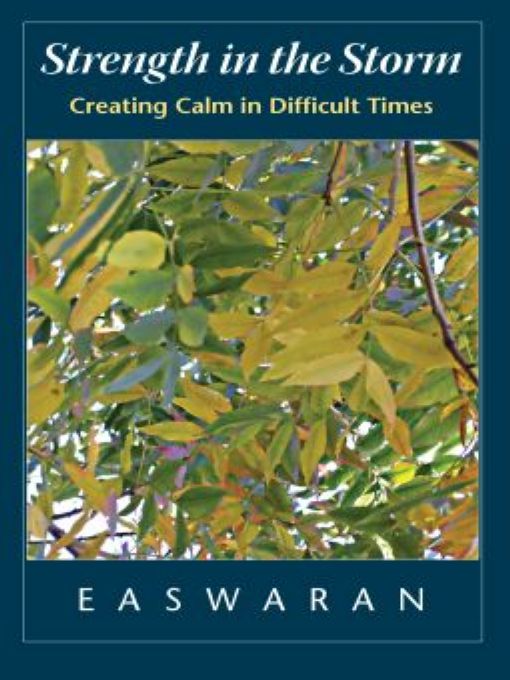
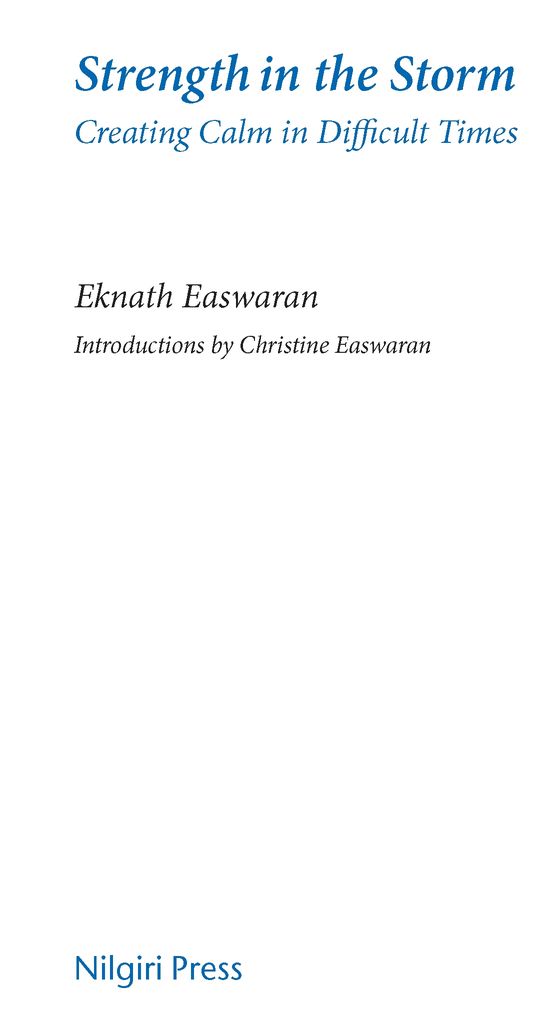
 An introduction presenting Easwarans timeless ideas in the light of problems and challenges that ordinary people face today.
An introduction presenting Easwarans timeless ideas in the light of problems and challenges that ordinary people face today. Easwarans article - the main part of each chapter - follows my introduction. Each article presents a key idea, such as how living in the present helps keep the mind calm and secure.
Easwarans article - the main part of each chapter - follows my introduction. Each article presents a key idea, such as how living in the present helps keep the mind calm and secure. A workbook section concludes each chapter. These pages, based on years of experience in presenting Easwarans teachings at retreats, are designed to help you get the most out of each article. A list of Key Ideas is followed by two pages of suggested activities - Points to Practice- and an inspirational passage of poetry or prose that speaks to the chapters theme. This is the same kind of passage used in Easwarans method of meditation, in which we absorb high ideals by filling our minds with them and then trying our best to live them out each day.
A workbook section concludes each chapter. These pages, based on years of experience in presenting Easwarans teachings at retreats, are designed to help you get the most out of each article. A list of Key Ideas is followed by two pages of suggested activities - Points to Practice- and an inspirational passage of poetry or prose that speaks to the chapters theme. This is the same kind of passage used in Easwarans method of meditation, in which we absorb high ideals by filling our minds with them and then trying our best to live them out each day.
